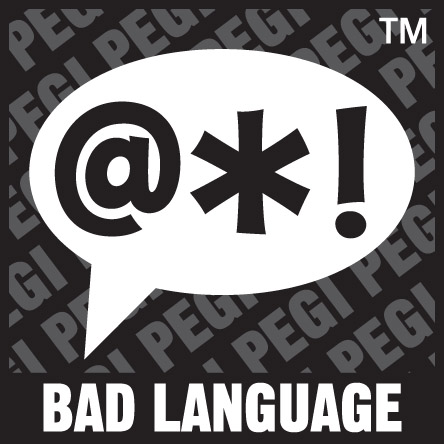Playing video games – gaming
- Intro
- What is PEGI?
- Why are video games appealing to children?
- Are video games good or bad for children?
- Positive aspects of playing video games
- Negative aspects of playing video games
- Parental controls as a way to protect children while playing video games
- Recommendations for parents of children who play video games
Playing video games – gaming
Author: Dobrinka Kuzmanović, PhD

Play is the most important activity of children in early ages. It helps development of the overall personality of the child, his/her intellectual, social, emotional, moral and physical development. Globally, playing is one of the most common activities of children (of all ages) on digital devices. Owing to the rapid technological development, it is now possible to play video games of various genres, on various devices (computer, video game console, smartphone or tablet), individually or with other players (or groups of players) from any part of the world and at any time.
An increasing number of video games (especially the fast, action ones) require a device with a powerful graphics card and processor, large amount of RAM and a fast performing hard disk.
Modern video games bear many risks that did not exist in classic games, and they are related to the risks of using digital technology in general. In the abundant offer of video games, a large number of those contain violence.
Some video games are suitable for players of all ages, others only for older children and younger teenagers, while some of them are for adults only.
When it comes to children, the key role in choosing appropriate video games is assigned to parents, or adults who participate in their upbringing and education.
The choice of video games can be guided by the existing standards for their rating (the most popular system in Europe is PEGI).

What is PEGI?
(Pan-European Game Information) is a pan-European system for assessing age-appropriate content of video games, established in 2003 by the European Commission. Today it is used in nearly 40 European countries, including Serbia.
The PEGI system helps parents to make informed decisions when buying video games for their children. There are labels indicating the age for which a particular video game is appropriate and what it contains. For example, if there is a label PEGI 7 on a game, it means that the video game is intended for children who are 7 or older.
It is important to understand that PEGI labels do not consider the level of difficulty (cognitive difficulty), but rather the age suitability of the game: e.g. a video game labelled PEGI 3 does not contain any inappropriate content, though it may be difficult for a child younger than the age indicated. Also, a PEGI 18 game could be easy to play, but it contains elements that make it inappropriate for younger players.
The following text provides an overview of PEGI labels with an explanation of their meaning. It was downloaded and adapted from the official PEGI website.
PEGI age ratings
| Label | Description |
 | The content of a game with this rating is considered suitable for all age groups. The game should not contain any sounds or pictures that are likely to frighten young children. No bad language should be heard. A very mild form of violence in a comical context is acceptable. |
 | Game content with scenes or sounds that can possibly frighten younger children should fall in this category. Very mild forms of violence (implied, non-detailed, or non-realistic violence) are acceptable for a game with this rating. |
 | Video games that show violence of a slightly more graphic nature towards fantasy characters or non-realistic violence towards human-like characters would fall in this age category. Sexual innuendo or sexual posturing can be present, while any bad language in this category must be mild. Gambling as it is normally carried out in real life in casinos or gambling halls can also be present (e.g. card games that in real life would be played for money). |
 | This rating is applied once the depiction of violence (or sexual activity) reaches a stage that looks the same as would be expected in real life. The use of bad language in games can be more extreme, while games of chance and the use of tobacco, alcohol or illegal drugs can also be present. |
 | The adult classification is applied because the level of violence reaches a stage where it becomes a depiction of gross violence, apparently motiveless killing, or violence towards defenceless characters. The glamorization of the use of illegal drugs and explicit sexual activity should also fall into this age category. |
| Label | Video game content description |
 | The game contains bad language (e.g. sexual expletives or blasphemy). This descriptor can be found on games with PEGI rating 12, 16 and 18. |
 | The game contains depictions of ethnic, religious, nationalistic or other stereotypes likely to encourage hate and discrimination. This descriptor can be found on games with PEGI 18 rating (and is likely to infringe national criminal laws). |
 | The image depicts the use of illegal drugs, alcohol or tobacco. Games with this content descriptor are always PEGI 16 or PEGI 18. |
 | This descriptor may appear on games with a PEGI 7 if it contains sounds that may be frightening or scary to young children, or on PEGI 12 games with horrific sounds or horror effects (but without any violent content). |
 | The game contains elements that encourage or teach gambling. Games with this sort of content are PEGI 12, PEGI 16 or PEGI 18. |
 | This content descriptor can accompany a PEGI 12 rating if the game includes sexual posturing or innuendo, a PEGI 16 rating if there is erotic nudity or sexual intercourse without visible genitals or a PEGI 18 rating if there is explicit sexual activity in the game. |
 | The game contains elements of violence. In games rated PEGI 7 this can only be non-realistic or non-detailed violence. Games rated PEGI 12 can include violence in a fantasy environment or non-realistic violence towards human-like characters, whereas games rated PEGI 16 or 18 have increasingly more realistic-looking violence. |
Although each video game should have a label clearly indicating the age it is intended for, some games do not contain a PEGI rating. PEGI ratings provide useful information about the video game; however, parents are the ones who will best estimate whether the particular game is appropriate for their child, once they get familiar with it.
Bear in mind that the label found on a video game is not a 100% guarantee that it contains exclusively items relevant to the child’s indicated age!
Why are video games appealing to children?

Being aware of the widespread distribution of video games among children of different ages, it is reasonable to ask why they are so appealing to children. We list several reasons:
- Video games contain dynamic images that change quickly and attract players’ attention
- They provide an opportunity for the child to actively control events on the screen (as opposed to television screens or a printed book where the role of the child is mainly passive)
- They contain sound effects and automatically display the points won
- There are different game levels with challenges posed upon players; they offer the possibility to progress and ‘break personal records’, motivating the players to continue playing
- Originality, credibility and authenticity of characters (quality of animation, graphics)
- Playing some types of video games can be very exciting, cause different emotions, and the human brain is designed to strive for new, exciting and diverse experiences
- They encourage players to compete (with themselves and other players)
- They are fun
- New generation video games have special effects, removing the boundary between real and virtual (the so-called virtual and augmented reality video games).
An extra reason that should be added to the list is that video games are popular in the peer group, which plays an important role in young people’s socialization.
Are video games good or bad for children?
Along with the appearance of the first video games, the question about the nature of their influence on children’s development was raised. The public (professional and non-professional) has different opinions on this issue (the same applies when it comes to the impact of digital technology on its users). If you dare to look for the answer to the question of whether video games are good or bad for children on some of the ‘non-commercial’ web search engines, you will face contradictory and radically opposing standpoints.
Scientists have no concrete and clear answer to this question. The results depend on several factors, including the applied research methods. Even when the connection between playing violent video games and violent behaviour is determined, this does not mean that playing such video games is the (only) reason that causes violent behaviour.

Video games are not bad in their essence. They can be both good and bad, depending on the type or genre of the game, the time spent playing, the goal of the game, the existence of a balance between playing video games and other activities, etc.
Positive aspects of playing video games
Though the most studies on video games are focused on their negative effects, recent research points to some advantages of playing video games:
- Playing some video games (e.g. fast action ones) requires intellectual and perceptual skills such as spatial and peripheral perception, mental rotation, visual attention, quick response
- Playing some video games (e.g. strategic ones) provides players with problem-solving skills
- They improve memory and inference
- Group gaming is a specific social experience since that is how new people are met and teamwork skills acquired (millions of people around the world gather together in virtual groups to play certain video games)
- Gaming positively affects one’s mood, players enjoy playing
- Playing video games contributes to perseverance, empowers self-confidence as well as coping with failure.
Negative aspects of playing video games
When playing video games (especially online), children may face many risks. What are they?
- Dependence on video games is one of the most serious negative aspects of playing video games. Playing video games stimulates the secretion of dopamine (a chemical substance produced by our body, responsible for regulating our mood and energy levels) and easily leads to making a habit of playing, which is also characteristic of other activities on digital devices with an interactive component (e.g. email, chatting). As Small and Vorgan described in their book iBrain, “young digital natives are stunned by flashy graphics and dependent on intense visual stimulus that shifts quickly.”

Excessive gaming can result in problems with sleep, diet, poor school achievement and difficulties in dealing with others. In extreme cases it can seriously endanger daily social and psychological functioning of the child. The World Health Organization has recently recognized video game addiction as a mental disorder, although there is no consensus among experts on this issue.
- Communication with strangers and potential Internet predators (exchange of private messages, chatting in the game or conversations with headphones and microphones children use for gaming).
- Exposure to harassment or digital violence by other players or a group of players (due to the possibility of anonymous opening profiles in online games).
- Exposure to harmful and age-inappropriate content (video games containing violence, explicit sexual content, drug use, gambling). The impact of violent content in video games on children has been the subject of numerous studies and, as mentioned earlier, there are no unequivocal findings.
- Sharing personal information with strangers.
- There is a possibility of spending money during the game, i.e. paying for additional content or features that are not available in the free version of the game.
- Downloading malware or a virus (e.g. through messages from other players).
Parental controls as a way to protect children while playing video games
All video game consoles, mobile devices (phones and tablets) and computer operating systems are equipped with a parental controls system that protects the privacy and safety of children while playing. Parental controls enable parents to:
- choose the games a child can access on a digital device he/she uses (based on PEGI or some other classification)
- manage the amount of time a child can spend playing video games
- adjust and control who the child communicates (chats) and exchanges information with (e.g. messages)
- have control over spending money while playing games.
Recommendations for parents of children who play video games
- Always pay attention to the age restriction indicated on the video game (PEGI rating or other system, depending on the country)
- Read the content of a video game, reviews, comments and ratings from other users, parents, experts.
- It would be ideal if you yourself tried to play the game before giving it to your child; if this is not the case, take part in the game.
- Be next to the child while playing video games, talk to him/her about what he/she likes and dislikes about the particular game.
- Bear in mind that when playing video games, a child might make contacts with strangers/other players.
- Explain to your child what personal information is and why it is important not to share it with others.
- Explain why some video games are not suitable for your child’s age.
- Together with your child, define the amount of time in a week that can be spent on playing video games, i.e. in front of the screen.
- Define the time the child can play video games (establish rules and abide by them consistently).
- Bear in mind that while playing a video game, a child might have the option of purchasing additional content (which can make the game inappropriate for the child’s age) and spending money.
- Apply parental controls and other technical protection measures, especially when it comes to younger children.




